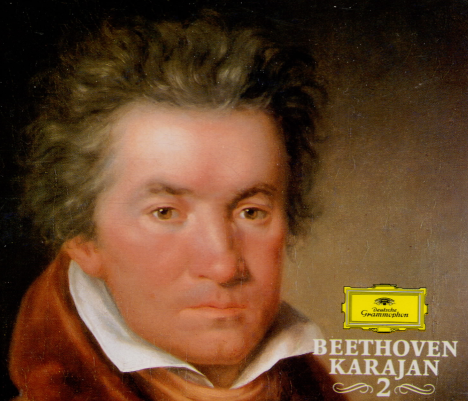Beethoven’s Symphony No. 4 is far much less known to general public, and less commented by scholars over the years. After his groundbreaking Eroica the Third, what Beethoven immediately started working on was actually this C minor symphony, the great Fifth as we know today, around the year of 1804. That work took him four years to complete.

DG Beethoven 9 Symphonies (1963) 429036-2
It was during the summer of 1806 when Beethoven was commissioned to compose a symphony for Count Franz von Oppersdorff who adored his symphony in D major. So he put aside his work on the Fifth, and produced his Fourth Symphony, in a fairly short amount of time.
Goerge Grove accurately assessed this work’s place amongst all Beethoven’s symphonies: the B flat Symphony is a complete contrast to both its predecessor and successor, and is as gay and spontaneous as they are serious and lofty. And this, perhaps, is one reason for the fact that No. 4 has never yet had justice done it by the public.[1]
1. Adagio – Allegro vivace
The 2:45 long introduction, slow, mysterious and gloomy in minor mode, sounds completely detached from the whole symphony. Bernstein put it right: “during the introduction we don’t yet know the four jolly movements that are to come, so it’s not the introduction that is the surprise at all, but the whole symphony which is to follow”; so in that sense, this work is the biggest surprise package that Beethoven has ever handed us.[2]
The main theme is prominently announced and brought in by the whole orchestra filled with excitement and joy:
After the subject iterates through woodwinds there is this phrase of syncopation that keeps coming back throughout the movement, supporting the overall energetic and playful mood:
The second subject has two parts, part 2A is first introduced on woodwinds led by bassoon:
and shortly followed by part 2B on clarinet:
2. Adagio
The Adagio is truly elegant and beautiful, this is the movement I’d be willing to repeat after one full listening of the work. Here’s the first subject on the strings, so lovely and relaxed:
The second subject led by clarinet is more appealing, it’s somewhat reminds me of the peaceful pastoral scene we so enjoyed in his Sixth Symphony:
it has an extended part led by the French horn, just cannot be more apt to the mood here:
It’s worth bringing out this following passage that ends the development and begins the recapitulation. As the bassoon emerges from beneath the strings and starts reprise of the accompaniment rhythm that starts the movement (originally on strings), clarinet seeming is about to call the main subject, but it sounds so distant and soon fades away; then when the horn echoes with the accompanying rhythm, now on tympani, comes the beautiful flute climbing up the scale and starts the singing of the main subject. This is pure magic:
3. Allegro vivace
The scherzo movement is actually a minuet and trio. It opens right into the principle subject, fast and syncopated to enhance the almost wildly joyful spirit:
The contrasting trio plays out on woodwinds with calm and grace, while the violins hover around with humorous jumpy tunes:
4. Allegro ma non troppo
The finale comes back in full force, filled with vibrant rhythms and exhilarating melodies. The violins play out the fast main subject:
Even when the oboe brings out the second subject, we still hear the busy accompaniment of the strings on the background:
As such, the momentum continues and never slows down a bit all the way till the end:
If Beethoven’s Fourth does not sound as gigantic piece as its predecessor and successor, well, it’s simply because it is not. Overall the symphony falls back to the style of his first two, joyful and exquisite as it may be, it is far from being an emotional heavyweight. The work is much less seen on concert programs, and I bet people (myself included) listen to it much less often than other Beethoven symphonies. Is it a pleasant piece to for me listen to? Certainly. Does it stir up any emotional turbulence and make you want to keep coming back to it? No.
[1] Grove, George (1896). Beethoven and His Nine Symphonies. London: Novello. p. 98
[2] Leonard Bernstein Discusses Beethoven’s 4th Symphony, clip on Youtube.com

